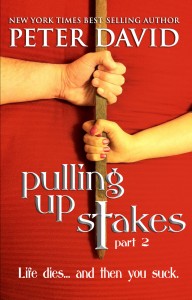 Originally published February 13, 1998, in Comics Buyer’s Guide #1265
Originally published February 13, 1998, in Comics Buyer’s Guide #1265
“Only half a million copies.”
It was some years back, during the pinnacle of the sales boom for comic books. There was an editor walking around the offices at Marvel Comics, and he was sorely distressed, angry and disappointed. You may ask, Why was he so angry?
Go ahead. Ask.
I’m not going to tell you unless you ask. Come on. Say it out loud. Say it with me: Why was he so angry?
You didn’t say it, did you? I’m not kidding now. Together: Why. Was. He. So. Angry?
(It’s amazing how punchy this column can get when I produce one after, say, finishing a Star Trek novel, dialoguing half an issue of Hulk, and plotting Aquaman, all within a fifteen hour period operating on three hour’s sleep. But I… something or other, I forget.)
You know what? I bet you didn’t say it out loud. After all that, you still didn’t say out loud, “Why was he so angry?” Not the slightest bit of effort did you invest in this discussion. Okay. Okay, fine. You’re going to be that way, I’m going to play hardball too. You’re going to have to wait until next week to find out why the editor at Marvel Comics was so angry, and why he’s probably long gone by now, and how to write a guaranteed bestselling comic. Because you wouldn’t play along when I just wanted to have some fun.
Instead I’m going to tell you stuff I noticed in the Star Trek: The Next Generation Technical Manual.
This would be the official, accept-no-substitute item by Rick Sternbach and Michael Okuda. Mike Okuda, by the way, is a certifiable genius. Or at the very least certifiable. Mike has been a tremendous help on any number of occasions in the years that I’ve been producing Star Trek novels, and he is one of the unsung heroes of the art of plotting episodes in that he is the foremost master of technobabble in the entire civilized world. It’s incredible. I mean, you think the Klingon language is impressive? That’s nothing! Mike comes up with this stuff, it’s unbelievable.
Example: I was working on a Deep Space Nine novel called The Siege. The title alone of that one is a bizarre enough story: Pocket Books wanted to have an original DS9 novel (the first!) on the stands barely a month or two after the series hit the air, and I was the author they approached about it. In the same conversation during which then-editor Kevin Ryan signed me on to the book, he also informed me that the title was going to be The Siege. When I asked why, he told me that they’d already solicited the book and come up with a title so they’d have something to put on the book, but no one had any clue (including me) as to what the thing would be about. “You can do whatever you want with the story,” he said, “but just be sure there’s a siege in it.” The story in fact had nothing to do with a siege, but I shoehorned in a mention of one and everyone was happy. I got revenge a few years later, though, when Pocket approached me about writing the first Voyager novel. I told them I needed time to make up my mind, and they said, “Okay, fine, but while you’re making up your mind, we need a title for solicitation.” So I figured that if I went for something really specific, like The MegaBabes of Plexi 3, that would hog-tie the writer—which would be really unfair in case it wasn’t me. I needed something exciting but vague. So I said, “Well, chances are that they’ll be trapped at some point or other, and they’ll have to escape from whatever predicament they’re in, so call it The Escape.” And I wound up not writing it because I was somewhat underwhelmed by Voyager and decided to pass up writing the novel, and another writer wound up writing the first Voyager novel which carried my title, but nothing else by me. (I haven’t read it, but I understand that it doesn’t feature an escape anywhere in the book. Ah well.)
4rce85ftgbvynui mol
Excuse me. I slumped forward and my head hit the keyboard. I’ve just got to do something about these twenty-one-hour work days.
So, at any rate, while I was working on The Siege, I had a plot point that needed attending to. So I called up Mike and I said, “Mike, the plot for my book requires that something happens to the Bajoran wormhole that renders it useless for a period of time—say, a few days. No one can go in or out because otherwise Something Bad Happens. It’s not something that’s done to the wormhole by bad guys or anything; it has to be something natural, the wormhole equivalent of sunspots or something.”
And Mike said, “Say that the wormhole is undergoing subspace compression.”
I said, “Ahhh. Subspace compression. And what would that be?”
“I have no idea,” said Mike. “It’s whatever you want it to be.”
Genius. I love Mike. He views the Trek universe like no one else does.
Where was I? Oh yeah. Technical manual.
In the Star Trek: New Frontier novel I was working on, I was setting an extensive sequence in and around the warp core. Since I wanted to make sure that everything was just right, not only did I consult with Mike on a couple of points, but I also diligently read the tech manual. And I started noticing stuff. Stuff that is so loopy that it borders on the subversive.
For instance, on pages 59-60, it discusses in very serious, highly technical terms, the workings of the matter/antimatter reaction chamber. Get this:
The equatorial band of the chamber contains the housing for the dilithium crystal articulation frame (DCAF). An armored hatch allows access to the DCAF for crystal replacement and adjustment. The DCAF consists of an EM-isolated cradle to hold approximately 1200 cm (cubed) of dilithium crystal, plus two redundant sets of three-axis crystal orientation linkages. The crystal must be manipulated with six degrees of freedom to achieve the proper angles for reaction mediation.
Now as you’re reading through all that gobbleygook, you find yourself looking at diagram 5.2.4 which displays the matter/antimatter reaction injectors. And it looks real familiar, an inverted pyramid. Bears a resemblance to the Apollo capsules, but there’s something else. And suddenly it hits you. It looks like a coffee filter. And the whole thing keeps talking about crystals. Dilithium, granted, not Folgers, but even so…
And look at the clincher: The Dilithium Crystal Articulation Frame? DCAF? The ship runs on Decaf? Now maybe I’m reading too much into this, but I don’t think so. I think the tech manual is basically saying that the whole dámņëd Enterprise is powered via a gigantic Mr. Coffee. It would certainly explain why, particularly in original Trek, they were so coffee-happy. Now we know where they got it from: They just poured cups directly out of the engines. Boy oh boy, that’ll wake you up in the morning, huh?
But that’s nothing compared to page 146, where they discuss Waste Management. Under “Water and Sewage Recycling,” we are informed:
Each crew member aboard the Enterprise typically generates approximately 52 liters of wastewater and sewage per day. This wastewater is pumped to treatment and recycling units. Preliminary treatment is accomplished by a series of mechanical filtration processes that remove solids and particulates. (The residue is conveyed to the organic waste processing system for further treatment and recycling.) Osmotic and electrolytic fractioning is then employed to remove dissolved and microscopic contaminants for treatment and recycling. The resulting water is superheated to 150 degree C for biological sterilization before being subjected to a final mechanical filtration stage, then it is returned to one of several freshwater storage tanks for reuse.
The various waste sludges recovered from the water recycling processes are a valuable resource. The organic waste processing system subjects the sludge to a series of sterilizing heat and radiation treatments. The waste is then electrolytically reprocessed into an organic particulate suspension that serves as the raw material for the food synthesizer systems. Remaining byproducts are conveyed to the solid waste processing system for matter replication recycling.
Aw, man!
If I’m reading this right, then what they’re saying is that they eat and drink their own bodily waste.
Aw, man!
I mean, yuck! I know it’s been reprocessed, I know it’s been treated, but yuck! Just think of all the off-hand comments and terms that take on new meaning.
The mess hall. Literally.
Or if somebody’s sitting there in the mess hall and they don’t like the taste of the food, they say, “Aw man, this tastes like crap! What kinda crap is this?”
Does anyone bother to wash their hands after relieving themselves because, y’know, what’s the point, they’ll just be eating it again in the next day or so.
And boy, Commander Riker being Number One? Yeesh. Makes you sorry for Commander Data, a.k.a. Number Two.
And just imagine someone getting up after a snack on the Enterprise, wearing the kind of wide smile generally referred to as “a šhìŧ-eating grin.”
Or if one angry crewmember says to another, “Eat šhìŧ and die!” well, heck, you’re halfway there.
It even explains why the Tribbles multiplied so quickly after consuming the food on the Enterprise, including Kirk’s chicken sandwich and coffee (and God only knows where that came from). It was as if they were being spread with fertilizer.
It even explains why so many episodes of Trek have left you with a bad taste in your mouth. I mean, you think Soylent Green being people was bad? That’s nothing compared to what’s in the tuna surprise on your average starship.
Hey, don’t get mad at me! It’s one in the morning, my brain’s going in weird directions, and besides, I’m not the one who came up with the idea! I just pointed it out, that’s all! Don’t shoot the messenger. Besides, I don’t have to take any crap from you. I could always join Starfleet for that.
(Peter David, writer of stuff, is going to sleep now.)






“Captain, if I give her any more, she’ll blow!”
“I don’t care, Scotty… I need my grande double-soy-latte-half-caf-triple-espresso-hazelnut-creme-mocha cappuccino! Put more beans in the chamber now, mister!”
Ðámņ, I forgot how funny this column was. I wonder if the old adage about being what one eats applies here as well? Could explain most of the seasons of Enterprise since their… uhm… conversion process for the waste material wasn’t as highly developed at that stage of the game.
I do seem to remember a few hints at this topic in the Star Trek novel How Much for Just the Planet and the dining area conversation between Bones, Spock and Kirk.
I made the mistake of reading this while my wife,who gets quite irritable when needing a nap was trying to take one. I only now need to know who to send my hospital bill to. Do I send the costs to you personally or do I send it to your business address. OWWW!!! My head still hurts.
Yep, it’s a coffeemaker. Look up “Chemex” on Google (or go to a Peet’s Coffee shop – they sell ’em.)
And that (including DCAF) is Mike Okuda’s sense of humor. A few years before this BiD was originally written, the California Academy of Sciences in San Francisco had a huge “The Science of Star Trek” exhibit, with a ton of the various Okuda-designed control panels from TNG & DS9 incorporated into it. Finding all the gags he put in those was a secondary exhibit all on its own. (I distinctly remember one labeled “Field Display” with a scale of 1B-2B-3B-HR.)